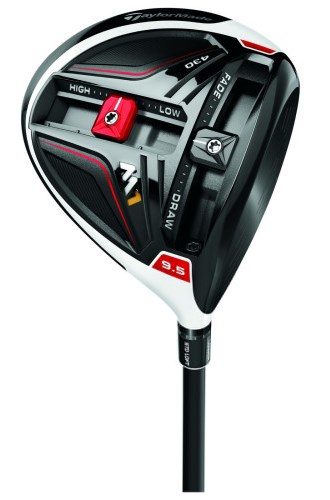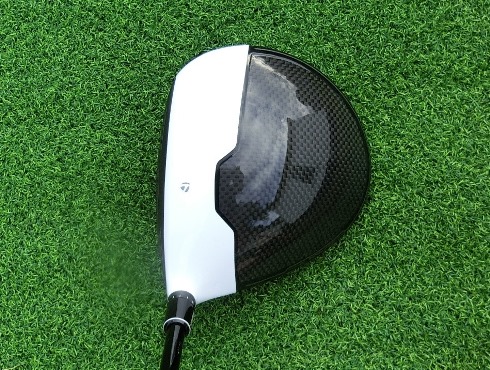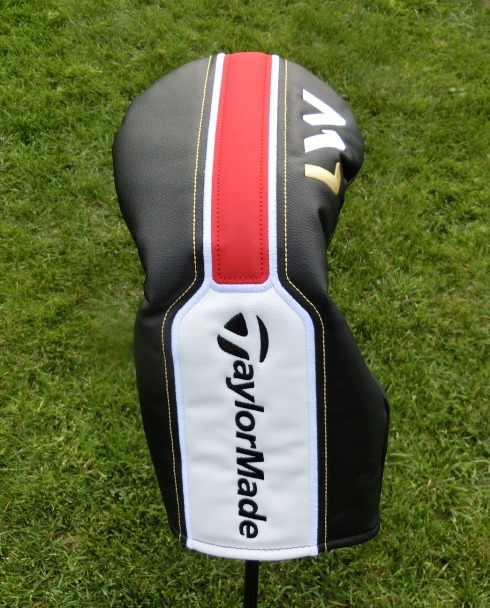 TaylorMade introduces its first multi-material driver, the M1 Driver, with a carbon fiber crown and new T-Track adjustable weight system. The carbon fiber crown allows TaylorMade to shift even more weight lower in the head for a lower center of gravity. The T-track’s tungsten weights provide independent positioning to change both spin and flight. Let’s take a look at the new driver and how it performs.
TaylorMade introduces its first multi-material driver, the M1 Driver, with a carbon fiber crown and new T-Track adjustable weight system. The carbon fiber crown allows TaylorMade to shift even more weight lower in the head for a lower center of gravity. The T-track’s tungsten weights provide independent positioning to change both spin and flight. Let’s take a look at the new driver and how it performs.
Technology and Design
Carbon fiber has long been coveted for its light weight and great strength. It is used in many applications from high end automotive components to aerospace. In golf, we have had carbon fiber shafts since the 1970s. The strength-to-weight ratio of the carbon fiber shaft allowed faster swing speeds by reducing the overall weight of the club.
A few companies have tried carbon fiber club heads with titanium faces with some success, but the trend did not catch on to other makers. This is because carbon fiber does have some properties that are not ideal for every application. Damping is a property where vibration through a material is absorbed, reducing the overall amplitude of the vibration waves. This is great for golf shafts to reduce the harsh vibration of impact. Many senior golfers switch to carbon fiber shafts for all their clubs for this reason. It is especially useful for arthritic hands.
But for golf club heads, carbon fiber softens the sound of impact. Sound is more important for golfers than many of us realize. It gives us audio feedback of good contact. We feel and hear a shot on the sweet spot of an iron or metal wood. When watching pro players in person, we marvel at how their shots sound along with the extra distance they get.
The first carbon fiber driver heads had this issue. They sounded dead at impact. The drivers performed well, but many golfers did not like the sound. This is the reasoning TaylorMade revealed for taking a long time to develop their first multi-material driver, the M1. They wanted it to sound as good as it performs.

The carbon fiber crown shows the weave for a high-tech look.
The M1 head is predominantly titanium with a crown made of carbon fiber. From the TaylorMade M1 website:
The M1 driver has a multi-material construction, highlighted by a proprietary 7-layer carbon composite crown. The crown is precision-formed and built ultra-thin, ultra-lite and high strength to maximize weight savings. This savings was repositioned to build a weight-loaded sole, moving overall clubhead weight lower and center for a more efficient power transfer.
TaylorMade M1 Website
Below is the the metal body of the head. What appears to be just reinforcing ribs are also designed to help focus the sound at impact. The carbon fiber crown still dampens sound somewhat, but the acoustics are improved with the internal design changes.

The structural ribs are designed to focus sound at impact.
The ultralight crown frees up weight and allows TaylorMade to move that weight to the new T-Track system. The T-Track design requires more weight for the two individual tracks. Previous TaylorMade moveable weight systems had limits to the weights themselves and only two or three different positions for the weights. The SLDR Driver had one weight in a front track. The R15 introduced a front track with two individual 12.5g weights that could be moved separately. The T-Track of the M1 has 25 total grams of weight with 15g for the front track and 10g for the back. The weights are tungsten and have 13 positions for the front track and another 13 for the rear for a great deal of possible combinations. TaylorMade claims being able to move two weights independently versus one or two in one track is a significant improvement in adjustability.
A bonus for the front track is that it also acts as a speed pocket. Speed pockets provide more spring in the face and help increase distance on hits low on the face as discussed in our Aeroburner Review.
Lastly, the M1 features the same hosel adjustment as the R15 driver with +/- 2 degrees of loft and lie adjustment. The adjustment are not independent and also affect face angle at setup.
Specifications
The M1 is available in a 460cc and 430cc version with a swing weight of D4.
Driver Volume Lofts (* = LH) Lie Length ------------- ------ ---------------------- --- ------ M1 460cc 8.5, 9.5*, 10.5*, 12 56-60 45.5" M1 430 430cc 8.5, 9.58, 10.5 56-60 45.5"
The M1 is available in three stock shafts, but TaylorMade also offers 28 other shafts at no upcharge. That is an excellent deal for those of you who have a favorite shaft. The M1 430 is not available in a left handed version.
Stock Shafts
FUJIKURA PRO 60 – Stiff, Regular, Senior – High Launch
MITSUBISHI KURO KAGE TiNi SILVER 60 – X-stiff, Stiff, Regular – Mid-Launch
ALDILA ROGUE SILVER 70 – X-stiff, Stiff – Low Launch
Test Specifications
I went through a half hour fitting at the TaylorMade M1 Launch media event. My fitting results indicated I should play a 12 degree M1 460cc head with Fujikura Pro 60 stiff shaft to optimize my launch conditions. My driver swing speed is in the 93-97 range.

Fujikura Pro 60 stiff shaft. Lighter and high launching.
Esthetics
The first thing that jumps out at you when you see the M1 at address is the carbon fiber weave on the crown as seen in the above photo of the address position. This gives the head a cool, high-tech look. The white accents near the face provide a break between the face and crown and give a distinct line that helps alignment. Driver heads are big, and black on black designs can make it harder to aim the face.
The sole also has the high-tech look, but more importantly, a user friendly guide to adjustment. “Draw” and “Fade” clearly show how the front weight adjustment will affect ball flight. “High” and “Low” also make it very intuitive what the weight will do. This was an emphasis of the sole designers at TaylorMade: make it easy to figure out what adjustments will do.

The red rear tungsten weight is 10g. The front grey weight is 15g.
The driver face has a simple look with white lines on the grey metal face. I don’t really look at the face much unless I am checking where I made contact. The gloss white contrast of the crown makes a sharp line that aids alignment.
I have to say the headcover is a bit of a let down. An expensive, high-tech driver having a low tech and inexpensive looking headcover is a disappointment. The cover has a loose fit and although the colors are nice, it looks bland. TaylorMade could have done better on this.
The grip is a stock TaylorMade grip that is similar in feel to the GolfPride Tour Velvet. My shaft had a butt end measurement of 0.620″, so the grip felt slightly larger than a stock grip on a 0.600″ shaft.
Performance
I will break up the performance part of this review into two parts, my performance and that of PGA Pro Steven Bowditch. The man can hit the ball a long way. During the media event, TaylorMade put the M1 driver through the entire adjustment range with Bowditch demonstrating.
First, the driving range wasn’t quite long enough for Bowditch as he hit drives in the 310 to 330 yard range and the range was barely that. There had to be a few dozen balls in the woods. It is impressive to watch someone with his ability hit drives.
Second, Pros like Bowditch are very consistent with their swings. So adjustments to the M1 would be more authentic with him testing than a 12 handicap like myself. The front adjustment made a significant impact on ball flight. Bowditch prefers to hit a slight fade. It looked like a tiny pull fade from my angle, which was right behind him. With the front weight at full draw, the ball curved significantly left. On fade, it was even more of a fade. It estimate 50 or more yards from full draw to full fade during the test.
The height adjustment was more subtle. It increases or decreases spin because it moves 10 grams of weight, which shifts the center of gravity a bit. TaylorMade claims a change of +/- 150 rpm in spin. What this adjustment helps with is optimizing spin off the driver face with launch angle. Bowditch is a numbers guy and likes a specific launch angle/spin combination. He can dial this in with with the M1.
Bowditch also mentioned dispersion. He felt his previous driver, the Aeroburner, had more dispersion than he liked. He stated the M1 had less variation in testing for him than the Aeroburner. If fact, he liked it so much, he put it in his bag for the next FedEx cup tournament in Chicago as did Jason Day and Justin Rose.
I noticed a similar change in the ball flight off the face with the front adjustment when I tried the club. I could get the ball to curve both ways, but not with as much control as Bowditch obviously. I didn’t notice as much height change with the back weight. I got much more change with the hosel adjustment, which makes sense.
The hosel design is a bit complicated. Because the loft, lie and face angle are not independent, your adjustments are less intuitive. The Tuning Guide is available on the M1 Site. My miss has been a hook this year, so I like to set up to eliminate that with a more open face. I also don’t launch the ball that high, so to counter this, I like to increase the loft. But the adjustment for higher loft with this hosel, closes the face at setup by 4 degrees.
This is just the nature of this hosel design. With the R1, TaylorMade had a face angle adjustment at the base to counter the hosel change. But that added weight had to be removed from the adjustable weights. Luckily, I can counter the the face angle by shifting the front weight a bit towards fade. In addition, the rear weight will contribute to draw or a fade as well because it shift the center of gravity. With the weight back, the face may close a bit slower and promote a fade. TaylorMade also claims that the back weight in the furthest back position makes the driver more forgiving.
On the launch monitor, I was able to get some variation in spin by moving the back weight around. It wasn’t dramatic, but with a more repeatable swing, it will let you dial down the spin if need be. The front weight does make a lot of difference. Full fade or draw setting can change the face angle at impact. I would caution to use these adjustments in moderation. These won’t be a fix for a swing fault, but they can help tune in your face angle at impact.
For distance, I was careful to try and compare with my current driver at close to the same settings for loft and lie. Being different hosel designs, that was a bit tricky. However, I got it close. Results showed a bit more distance overall, around 2 to 5 yards. Spin was also a bit lower when I set the back weight to the center or all the way forward. I will need a bit more launch monitor time to dial this in and confirm the distances. With winter coming, I will have plenty of time.
The Fujikura Pro 60 shaft feels very similar to my Fujikura Motore F3 shaft, which I use with my other driver. The tip is not too whippy and the grip end feels firm but not harsh at impact. The butt end on the Pro 60 is a bit larger than many driver shafts. At 0.620″ it will feel thicker. This didn’t bother me as I use at least 3 layers of build up tape under my grips. When I replace the grip, I will just use less tape.
Lastly, sound. I’ve played a few rounds with the M1 and did a few ranges sessions with my other drivers to compare. The sound off the driver is different than most full titanium drivers but not nearly as muted as previous carbon fiber drivers. It has a very positive thwack off the face even on off center hits. It actually sounds similar to some titanium drivers that have a more muted sound. Frankly, I didn’t notice the sound much on the course. It’s easy on the range hitting different drivers back to back, but on the course, it wasn’t noticeable and certainly not unappealing.
Conclusion
At $499 retail, this is an expensive driver. With 28 premium shafts at no up-charge, the price feels a bit better, but it is still a good sized investment. TaylorMade as a number of fitting centers around the country. I recommend taking advantage of this. Getting fit will put you in the right shaft and they will help you dial in the best settings. TaylorMade Fitting Information
I do like this driver a lot because of the independent weight track feature. This really helps you be able to dial in the head to match your swing. The front track gives you the most flexibility, while the rear track only moderately adjusts spin. The stock Fujikura shaft fits my swing and feels similar to the Fujikura Motore F3 I use with my other driver.
The sound at impact is different than my other drivers, including the Aeroburner I reviewed previously. But the sound is not unappealing, and if I don’t think about it, I don’t notice it at all.
Check out the M1 Driver at TaylorMade’s site. They have a very cool presentation of the new driver with CAD drawings and exploded views.







I have a 430 with an aldila 44 magnum shaft . Good swings produce very nice shots but the driver seems a little less forgiving on marginal swings than my superfast. I think it has a chance to be a keeper but we will see. Looks like I need to learn to make more good swings.
Hi Scott Curry – Can you provide your M1 head settings from the this fitting? Reason I ask is we have similar swing speeds. Interested to see if they set it for high spin and any draw or fade settings. Thanks for the review